INSTITUT SUPERIEUR D'ANTHROPOLOGIE
INSTITUT OF ANTHROPOLOGY
COURS ONLINE – COURS A DISTANCE
INSCRIPTIONS OUVERTES
REGISTER NOW
INDE – 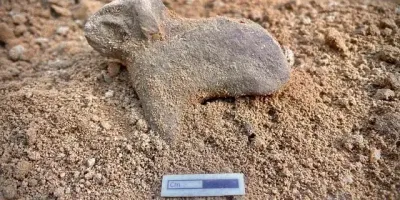 Keeladi - A total of 804 artefacts were unearthed during the ninth phase of the Keeladi excavation in Sivaganga district. In Keeladi, the artefacts unearthed from 14 quadrants include gold ornaments, ivory dice, terracotta animal figurines, gamesmen, spindle whorls, crystal quartz weighing unit, glass beads, bangle shards, copper coins and needles, bone points, and iron nails. "The bone and charcoal samples have been collected for scientific analysis," said department sources. They added that a floor, made of clay and lime, with a width of three to six has also been discovered. Other materials disinterred include a cluster of potsherds (black-and-red ware, red slip ware, and red ware potsherds), such as perforated potsherds, decorated potsherds, russet painted potsherds, and rouletted potsherds. "Over 200 graffiti-marked potsherds with fish, ladder, and geometric symbols were also identified," the sources said.
Keeladi - A total of 804 artefacts were unearthed during the ninth phase of the Keeladi excavation in Sivaganga district. In Keeladi, the artefacts unearthed from 14 quadrants include gold ornaments, ivory dice, terracotta animal figurines, gamesmen, spindle whorls, crystal quartz weighing unit, glass beads, bangle shards, copper coins and needles, bone points, and iron nails. "The bone and charcoal samples have been collected for scientific analysis," said department sources. They added that a floor, made of clay and lime, with a width of three to six has also been discovered. Other materials disinterred include a cluster of potsherds (black-and-red ware, red slip ware, and red ware potsherds), such as perforated potsherds, decorated potsherds, russet painted potsherds, and rouletted potsherds. "Over 200 graffiti-marked potsherds with fish, ladder, and geometric symbols were also identified," the sources said.
804 artefacts unearthed in Tamil Nadu's Keeladi, 24 burial urns in Konthagai- The New Indian Express
INDE – Konthagai - Kondagai, 24 burial urns were discovered. Over 110 black-and-red ware and red slip ware with grave goods were unearthed from the urns alongside human skeletal remains and nine artefacts, including carnelian beads, iron knives, chisels, rings, and others. "For the first time ever, a ring made of ivory has been found from a burial urn," said the department.
804 artefacts unearthed in Tamil Nadu's Keeladi, 24 burial urns in Konthagai- The New Indian Express
ITALIE – 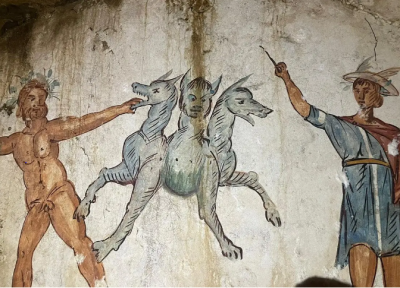
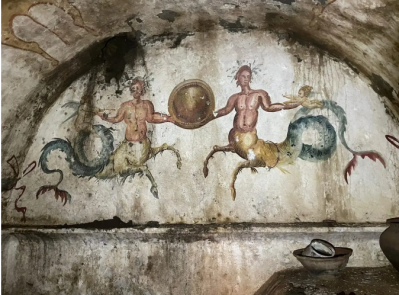 Giugliano - The discovery was made following an archaeological investigation in the Flegreo Domitiana area, where previous studies have found a high density of burials from the Republican Age to the Roman Imperial Age. The investigation identified an opus incertum wall first thought to demarcate the boundary of the necropolis, however, upon a closer inspection it was revealed to be the frontage of a monumental chamber tomb. The tomb was found with a slab made from tuff sealing the entrance, leading to a chamber with preserved frescos across the ceilings and walls. The most notable fresco depicts Cerberus (thus the tomb being designated “Tomb of Cerburus”), the three-headed dog from Ancient Greek mythology. Cerberus, also referred to as the “hound of Hades”, guarded the gates of the Underworld to prevent the dead from leaving. The scene represents the last of Heracles’ twelve labors, in which Cerberus is captured by Heracles. Also depicted in the tomb are mythological scenes of ichthyocentaurs, a centaurine-type sea creature with the upper body of a human, the lower anterior half and fore-legs of a horse, and the tailed half of a fish. The scene shows two ichthyocentaurs facing each other and holding a clypeus (a shield worn by the Greek hoplites and Romans), while being attended by two winged erotes (Roman Cupid-like babies). According to a press announcement by the Superintendent Of Archaeology, Fine Arts And Landscape For The Naples Metropolitan Area: “The tomb has frescoed ceilings and walls in perfect condition, with mythological scenes that go all around the room and figurative representations among which, a three-headed dog stands out. Three painted klìnai , an altar with vessels for libations, the deceased still placed on the funeral beds with rich objects – complete the picture of a discovery which, in this area, is unprecedented.”
Giugliano - The discovery was made following an archaeological investigation in the Flegreo Domitiana area, where previous studies have found a high density of burials from the Republican Age to the Roman Imperial Age. The investigation identified an opus incertum wall first thought to demarcate the boundary of the necropolis, however, upon a closer inspection it was revealed to be the frontage of a monumental chamber tomb. The tomb was found with a slab made from tuff sealing the entrance, leading to a chamber with preserved frescos across the ceilings and walls. The most notable fresco depicts Cerberus (thus the tomb being designated “Tomb of Cerburus”), the three-headed dog from Ancient Greek mythology. Cerberus, also referred to as the “hound of Hades”, guarded the gates of the Underworld to prevent the dead from leaving. The scene represents the last of Heracles’ twelve labors, in which Cerberus is captured by Heracles. Also depicted in the tomb are mythological scenes of ichthyocentaurs, a centaurine-type sea creature with the upper body of a human, the lower anterior half and fore-legs of a horse, and the tailed half of a fish. The scene shows two ichthyocentaurs facing each other and holding a clypeus (a shield worn by the Greek hoplites and Romans), while being attended by two winged erotes (Roman Cupid-like babies). According to a press announcement by the Superintendent Of Archaeology, Fine Arts And Landscape For The Naples Metropolitan Area: “The tomb has frescoed ceilings and walls in perfect condition, with mythological scenes that go all around the room and figurative representations among which, a three-headed dog stands out. Three painted klìnai , an altar with vessels for libations, the deceased still placed on the funeral beds with rich objects – complete the picture of a discovery which, in this area, is unprecedented.”
Sealed “Tomb of Cerberus” discovered in Giugliano | HeritageDaily - Archaeology News
ITALIE – 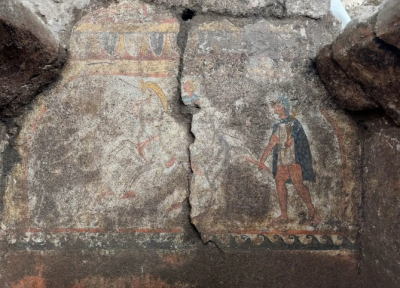 Pontecagnano - The Pontecagnano necropolis is located adjacent to an ancient Villanovan settlement (early Etruscan), which emerged east of the present-day city of Salerno, Italy. Previous excavations of the necropolis have yielded over 9,000 tombs and burials, dating from 3,000 BC during the Bronze Age, to the 3rd century AD in the Roman era. In a press announcement by the Superintendence of Archaeology, fine arts, and landscape for the provinces of Salerno and Avellino, a team of archaeologists have excavated a painted tomb from the 4th century BC, following the initial discovery during construction works. The tomb, designed number 10043, is lined with travertine blocks of stone and contains various imagery depicting scenes of Italic warriors. One of the warriors is shown riding a horse armed with a spear, while another warrior is cloaked and carrying what appears to be a club. The side walls are decorated with ornamental festoons and imagery of pomegranates. The tomb belonged to a high-status individual, who was buried with a gold leaf crown, of which only several fragments have been persevered. The tomb was likely constructed during the Etruscan expansion into the Salerno region and southern Italy, which would later be annexed by Greek colonists. According to the archaeologists, the discovery is a rarely in the wider necropolis, as only a handful of painted tombs from this period having previously been discovered.
Pontecagnano - The Pontecagnano necropolis is located adjacent to an ancient Villanovan settlement (early Etruscan), which emerged east of the present-day city of Salerno, Italy. Previous excavations of the necropolis have yielded over 9,000 tombs and burials, dating from 3,000 BC during the Bronze Age, to the 3rd century AD in the Roman era. In a press announcement by the Superintendence of Archaeology, fine arts, and landscape for the provinces of Salerno and Avellino, a team of archaeologists have excavated a painted tomb from the 4th century BC, following the initial discovery during construction works. The tomb, designed number 10043, is lined with travertine blocks of stone and contains various imagery depicting scenes of Italic warriors. One of the warriors is shown riding a horse armed with a spear, while another warrior is cloaked and carrying what appears to be a club. The side walls are decorated with ornamental festoons and imagery of pomegranates. The tomb belonged to a high-status individual, who was buried with a gold leaf crown, of which only several fragments have been persevered. The tomb was likely constructed during the Etruscan expansion into the Salerno region and southern Italy, which would later be annexed by Greek colonists. According to the archaeologists, the discovery is a rarely in the wider necropolis, as only a handful of painted tombs from this period having previously been discovered.
Painted tomb discovered at Pontecagnano necropolis | HeritageDaily - Archaeology News
ECOSSE –  Glencoe - They were hidden for safekeeping underneath a stone fireplace. But they were never retrieved until now, some 330 years later. Today archaeologists have revealed that a hoard of coins buried in a small pot, just discovered in Glencoe paints a fascinating picture of life for one Highland clan chief and his household. The site in Glencoe was used as a “summerhouse” and traditionally associated with Alasdair Ruadh “MacIain” MacDonald of Glencoe, chief of the MacDonalds of Glencoe from 1646-1692. The 36 coins, which vary in date, were discovered by University of Glasgow archaeology student Lucy Ankers in the grand fireplace of the Glencoe house during an archaeological dig in August 2023. The coins were found in a pot, with a small rounded pebble for a lid and hidden beneath a hearth stone stab. However, none of the coins were minted after the 1680s which has led archaeologists to suggest that they were most likely deposited under the fireplace either just before or during the 1692 Glencoe Massacre for safekeeping. Whoever buried the coins, did not return for them which could indicate that they were among the victims of the massacre.
Glencoe - They were hidden for safekeeping underneath a stone fireplace. But they were never retrieved until now, some 330 years later. Today archaeologists have revealed that a hoard of coins buried in a small pot, just discovered in Glencoe paints a fascinating picture of life for one Highland clan chief and his household. The site in Glencoe was used as a “summerhouse” and traditionally associated with Alasdair Ruadh “MacIain” MacDonald of Glencoe, chief of the MacDonalds of Glencoe from 1646-1692. The 36 coins, which vary in date, were discovered by University of Glasgow archaeology student Lucy Ankers in the grand fireplace of the Glencoe house during an archaeological dig in August 2023. The coins were found in a pot, with a small rounded pebble for a lid and hidden beneath a hearth stone stab. However, none of the coins were minted after the 1680s which has led archaeologists to suggest that they were most likely deposited under the fireplace either just before or during the 1692 Glencoe Massacre for safekeeping. Whoever buried the coins, did not return for them which could indicate that they were among the victims of the massacre.
University of Glasgow - University news - Coin hoard gives fascinating insight into life before the Glencoe Massacre
MEXIQUE - Atlixco - A new discovery has got archaeologists incredibly excited after they have found the remains of an ancient Mexican temple that was thought to be the stuff of legend. For years, a legend in the central Mexican city of Atlixco told of the existence of a lost temple (also known as a teocalli) built long before the arrival of the Spanish in the 16th century. The local Atlixquenses people believed the temple was built on the top of San Miguel Hill where, today, a Catholic chapel dedicated to the archangel Michael currently stands. But, despite the legend and rumours remaining strong, there has never been any archaeological evidence to back them up, until now. Thanks to work conducted by the Ministry of Culture of the Government of Mexico through the National Institute of Anthropology and History (INAH) remnants of the structure appear to have confirmed it is real and once existed. The incredible discovery was made by accident when the chapel’s lighting was undergoing renewal and the paths leading up to it were reinforced. During this work, a team of researchers found items over 1,000 years old that included stone tools, ornaments, and clay vessels, that were made by Mesoamerican Nahua indigenous people. Following this discovery, INAH archaeologists Miguel Medina Jaen and Carlos Cedillo Ortego, along with Elvia Cristina Sánchez de la Barquera, undertook survey work on the chapel grounds where they made the discovery of stone wall and floor remains from the ancient temple. They were found lying approximately 90cm below the foundations of the chapel and pre-date the current structure. According to an INAH statement, their discovery confirms that “a teocalli did exist on the summit of the hill, San Miguel, and that it had at least two construction stages.” Though it is not yet clear who the temple was dedicated to, the experts hope to gain more clarity as research continues, explaining “segments of the teocalli and greater clues to clarify which was its titular deity still lie under the viceregal chapel of San Miguel Arcángel”.
Temple thought to be the stuff of legend discovered in Mexico | indy100
TURQUIE –  Alexandria Troas – A team of researchers has uncovered a trove of 2,000-year-old bronze coins during excavations in the ancient city of Alexandria Troas, a historic port city that dates back to approximately 2,400 years ago, located in the northwestern province of Çanakkale. Archaeologists believe that these coins are from the end of the first century B.C. and the first quarter of the A.D. first century, making them approximately two millennia old. The dating of these coins aligns with the period when the city was transformed into a Roman colony. Excavation head Erhan Öztepe explained that the findings go beyond coins, as they have also discovered a wealth of ceramic artifacts during their systematic excavation work. Öztepe described their meticulous process, stating: "As we sift through the excavated soil, everything that comes out is first collected in the field, then washed and sorted. Ceramics and metal finds are separated. If there are any items requiring cleaning, our restoration experts conduct the necessary scientific analysis. After that, we move on to the evaluation stage." The ceramics discovered during this year's excavations span various periods from 1,700 to 2,000 years ago. Öztepe also highlighted the significance of human and animal bones found at the site, categorizing them into two groups: human-made bone artifacts and bone remains from humans or animals. Anthropologists have been specifically analyzing the bone remains of humans and animals, which has led to the identification of various types of domesticated animals such as sheep, goats and cattle, as well as wild animals including deer and even the bones of a rooster species, which is believed to have been consumed for the first time.
Alexandria Troas – A team of researchers has uncovered a trove of 2,000-year-old bronze coins during excavations in the ancient city of Alexandria Troas, a historic port city that dates back to approximately 2,400 years ago, located in the northwestern province of Çanakkale. Archaeologists believe that these coins are from the end of the first century B.C. and the first quarter of the A.D. first century, making them approximately two millennia old. The dating of these coins aligns with the period when the city was transformed into a Roman colony. Excavation head Erhan Öztepe explained that the findings go beyond coins, as they have also discovered a wealth of ceramic artifacts during their systematic excavation work. Öztepe described their meticulous process, stating: "As we sift through the excavated soil, everything that comes out is first collected in the field, then washed and sorted. Ceramics and metal finds are separated. If there are any items requiring cleaning, our restoration experts conduct the necessary scientific analysis. After that, we move on to the evaluation stage." The ceramics discovered during this year's excavations span various periods from 1,700 to 2,000 years ago. Öztepe also highlighted the significance of human and animal bones found at the site, categorizing them into two groups: human-made bone artifacts and bone remains from humans or animals. Anthropologists have been specifically analyzing the bone remains of humans and animals, which has led to the identification of various types of domesticated animals such as sheep, goats and cattle, as well as wild animals including deer and even the bones of a rooster species, which is believed to have been consumed for the first time.
2,000-year-old bronze coins unearthed in Türkiye's Çanakkale | Daily Sabah
COLOMBIE –  Santa María la Antigua del Darién - What appears to be an old stone dock emerges from the earth to the rhythm of the tap, tap, tap of shovels against rocks. It is one of the possible fluvial entrances to Santa María la Antigua del Darién, the first Spanish city founded on mainland America in 1510. Santa María la Antigua del Darién is located in the department of Chocó (northwest), in the town of Tanela.
Santa María la Antigua del Darién - What appears to be an old stone dock emerges from the earth to the rhythm of the tap, tap, tap of shovels against rocks. It is one of the possible fluvial entrances to Santa María la Antigua del Darién, the first Spanish city founded on mainland America in 1510. Santa María la Antigua del Darién is located in the department of Chocó (northwest), in the town of Tanela.
Colombia's Jungle Hides Ruins of First Spanish Colonial City : (ticotimes.net)
TURQUIE – 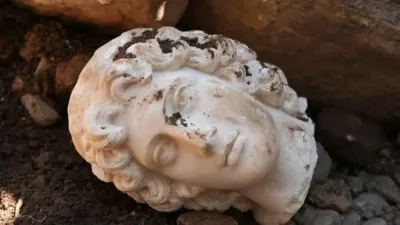 Bithynia- Archaeologists in Turkey have been conducting excavations in the Konuralp region for the past four years, with the support of the Düzce Municipality. Recently, a significant discovery was made in the upper part of a Roman theater—a head that has been identified as belonging to Alexander the Great. Over the course of a year, Düzce archaeologists have diligently uncovered a substantial portion of the ancient theater. Among the other historical treasures unearthed are an ancient statue of the Greek god Apollo and a head representing the dreaded Medusa. Within the excavation site of the Konuralp Ancient Theatre, archaeologists conducted meticulous and intricate work to extract what was identified as a portrait head of Alexander the Great. In an official statement, the Konuralp Museum declared, “This head of Alexander, which dates back to the 2nd Century A.D. and measures 23 cm, was discovered during the excavation of the Prusias ad Hypium Theatre, located in the Terzialiler area of Düzce, the ancient city of Bithynia.” The head, crafted from marble, features deep, upward-looking eyes and a slightly open mouth that doesn’t reveal his teeth. The long, curly hairstyle, parted to either side, along with the two tufts of hair (Anastoli) at the center of his forehead, which sweep back and to the sides, closely resemble the mane of a lion. This hairstyle is a distinctive characteristic associated with Alexander the Great.”
Bithynia- Archaeologists in Turkey have been conducting excavations in the Konuralp region for the past four years, with the support of the Düzce Municipality. Recently, a significant discovery was made in the upper part of a Roman theater—a head that has been identified as belonging to Alexander the Great. Over the course of a year, Düzce archaeologists have diligently uncovered a substantial portion of the ancient theater. Among the other historical treasures unearthed are an ancient statue of the Greek god Apollo and a head representing the dreaded Medusa. Within the excavation site of the Konuralp Ancient Theatre, archaeologists conducted meticulous and intricate work to extract what was identified as a portrait head of Alexander the Great. In an official statement, the Konuralp Museum declared, “This head of Alexander, which dates back to the 2nd Century A.D. and measures 23 cm, was discovered during the excavation of the Prusias ad Hypium Theatre, located in the Terzialiler area of Düzce, the ancient city of Bithynia.” The head, crafted from marble, features deep, upward-looking eyes and a slightly open mouth that doesn’t reveal his teeth. The long, curly hairstyle, parted to either side, along with the two tufts of hair (Anastoli) at the center of his forehead, which sweep back and to the sides, closely resemble the mane of a lion. This hairstyle is a distinctive characteristic associated with Alexander the Great.”
Remarkable discovery in Turkey: Alexander the Great's portrait head unearthed in Konuralp Ancient Theatre - Neos Kosmos
TURQUIE –  Assos - An iron trident, believed to be used for fishing, dating to the 3rd or 4th century A.D. has been discovered in the ancient Aegean coastal resort town of Assos in northwestern Turkey. The team was unearthed by archaeologists excavating the Nymphaion (eastern fountain), an ornate fountain on the east of the ancient city’s center. An expert restorer worked on the archeological find to clear the trident of soil and oxidized agents on it. The trident was found among pieces of the Nymphaion’s collapsed vault, and was instantly recognized as the business end of a hand-held fishing harpoon from its size and distinctive shape. Arslan told Anadolu that the fish spear was a material they have seen especially in murals and other depictions. “This is the first time we find such materials in Assos, because tools made of iron are the materials decaying most rapidly in ancient cities,” [Nurettin Arslan, humanities and social sciences professor at Canakkale Onsekiz Mart University,] said. However, this trident found in this structure is an important example in that it was found almost completely intact. “Although we know that such tools were widely used in ancient times, we can say that it is an important work since the examples that have survived so far are very rare. As far as we know, it is said or we see in descriptions that such tools were used in ancient times to catch big fish at sea in small boats by lighting them with a torch at night,” he added. Assos’ fishermen, who have made their living from the sea for thousands of years, probably had access to harpoons like this one that were made in the area. Archaeological evidence of iron smelting and working has been discovered in Assos, so it is possible that the metal came from the city. Assos, located in Behram Village in Ayvacık District of Çanakkale Province, was founded by immigrants from Lesbos (Methymna Settlement on Lesbos Island) in the 7th century B.C., according to ancient writers. It has been determined by recent archaeological studies that the history of the city dates back to the Bronze Age.
Assos - An iron trident, believed to be used for fishing, dating to the 3rd or 4th century A.D. has been discovered in the ancient Aegean coastal resort town of Assos in northwestern Turkey. The team was unearthed by archaeologists excavating the Nymphaion (eastern fountain), an ornate fountain on the east of the ancient city’s center. An expert restorer worked on the archeological find to clear the trident of soil and oxidized agents on it. The trident was found among pieces of the Nymphaion’s collapsed vault, and was instantly recognized as the business end of a hand-held fishing harpoon from its size and distinctive shape. Arslan told Anadolu that the fish spear was a material they have seen especially in murals and other depictions. “This is the first time we find such materials in Assos, because tools made of iron are the materials decaying most rapidly in ancient cities,” [Nurettin Arslan, humanities and social sciences professor at Canakkale Onsekiz Mart University,] said. However, this trident found in this structure is an important example in that it was found almost completely intact. “Although we know that such tools were widely used in ancient times, we can say that it is an important work since the examples that have survived so far are very rare. As far as we know, it is said or we see in descriptions that such tools were used in ancient times to catch big fish at sea in small boats by lighting them with a torch at night,” he added. Assos’ fishermen, who have made their living from the sea for thousands of years, probably had access to harpoons like this one that were made in the area. Archaeological evidence of iron smelting and working has been discovered in Assos, so it is possible that the metal came from the city. Assos, located in Behram Village in Ayvacık District of Çanakkale Province, was founded by immigrants from Lesbos (Methymna Settlement on Lesbos Island) in the 7th century B.C., according to ancient writers. It has been determined by recent archaeological studies that the history of the city dates back to the Bronze Age.
A 1,700-year-old trident discovered in Assos ancient city in Türkiye - Arkeonews